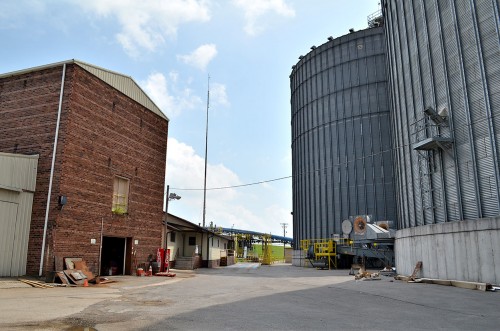 While researching the Saga of Sgt. Ginter, who is buried in the Mound City National Cemetery (as a sergeant, not as female camp follower in a Major’s uniform), I ran across some interesting tidbits of Civil War history about Mound City and Cairo, located about five miles apart on the Ohio River.
While researching the Saga of Sgt. Ginter, who is buried in the Mound City National Cemetery (as a sergeant, not as female camp follower in a Major’s uniform), I ran across some interesting tidbits of Civil War history about Mound City and Cairo, located about five miles apart on the Ohio River.
Mound City was the location of one of the largest Civil War hospitals in the western campaign. Even though no major battles were fought in the two cities, they received dead and wounded soldiers from Battles in Belmont, Commerce and Reed’s Point in Missouri; Fort Donelson and Shiloh in Tennessee; Fort Holt, Paducah and Columbus in Kentucky.
I was disappointed to learn that this brick building is all that’s left of what was described as one of the best administered of the military general hospitals.
Was also a naval depot
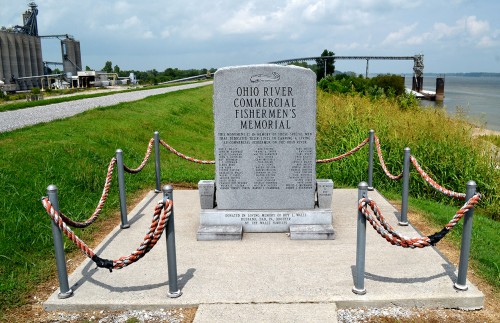 The National Register of Historic Places listing of Civil War Cemeteries contains the following information about Mound City. If you are interested in the cemetery part, here is a link to the full register.
The National Register of Historic Places listing of Civil War Cemeteries contains the following information about Mound City. If you are interested in the cemetery part, here is a link to the full register.
Mound City, Illinois, was founded at the abandoned settlement of Trinity in 1854. The city was located at the confluence of the Ohio and Cache Rivers. With the coming of the civil conflict, the riverfront became an extremely important Union naval facility for the Mississippi Squadron. A repair facility for the squadron was moved to Mound City due to the lack of space at Cairo.
Built three ironclads
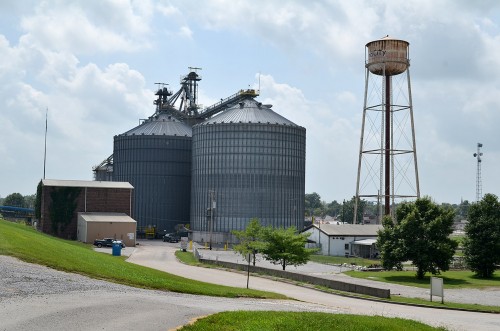 Throughout the Civil War, the Mound City naval depot was the only repair facility for the Mississippi Squadron, a fleet that numbered 80 ships. In addition to repairing and refitting vessels, the Mound City naval depot also shared in the construction of three ironclad gunboats. These were the U.S.S. Cairo, Cincinnati, and Mound City.
Throughout the Civil War, the Mound City naval depot was the only repair facility for the Mississippi Squadron, a fleet that numbered 80 ships. In addition to repairing and refitting vessels, the Mound City naval depot also shared in the construction of three ironclad gunboats. These were the U.S.S. Cairo, Cincinnati, and Mound City.
Heavy battles along the Tennessee, Cumberland, and Mississippi Rivers necessitated the establishment of hospital facilities to care for the wounded. Mound City was in a strategic location and the city’s hotel and foundry were converted into hospital facilities. High death rates from wounds and disease led to the establishment of the Mound City National Cemetery.
Red Rover hospital ship
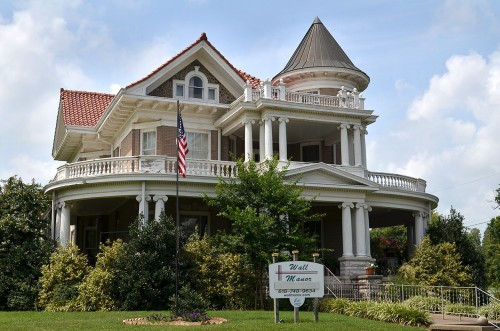 On April 7, 1862, the gunboat, Mound City, captured a side-wheel river steamer named the Red Rover which had been used by the Confederates as a floating barracks. The Red Rover was taken to St. Louis to be refitted as a floating hospital for the Western Flotilla. The ship was assigned to the U. S. Navy Hospital at Mound City.
On April 7, 1862, the gunboat, Mound City, captured a side-wheel river steamer named the Red Rover which had been used by the Confederates as a floating barracks. The Red Rover was taken to St. Louis to be refitted as a floating hospital for the Western Flotilla. The ship was assigned to the U. S. Navy Hospital at Mound City.
The Red Rover accompanied the flotilla through most engagements with the enemy, making many trips with wounded and dead to the Memphis and Mound City hospitals and cemeteries, treating the wounded along the bank of the Mississippi, scrounging for food and transporting medical supplies.
Important staging area
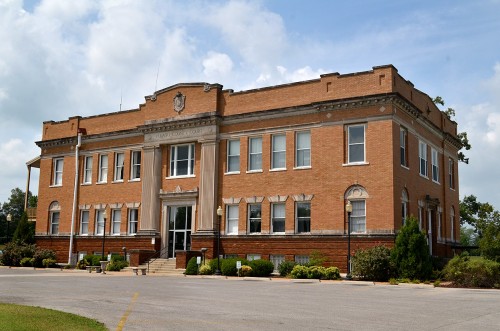 Although Mound City and nearby Cairo, Illinois, were not in the combat theater of the Civil War, their location near the confluence of the Ohio and Mississippi Rivers made these areas important staging points for the Tennessee and Cumberland Rivers for the Union forces. Three of the famous Eads ironclad gunboats were built at the Mound City marine ways and shipyard.
Although Mound City and nearby Cairo, Illinois, were not in the combat theater of the Civil War, their location near the confluence of the Ohio and Mississippi Rivers made these areas important staging points for the Tennessee and Cumberland Rivers for the Union forces. Three of the famous Eads ironclad gunboats were built at the Mound City marine ways and shipyard.
These specially designed shallow draft ironclads played an important part in the western campaign, giving valuable support to the Union troops on the Tennessee and Cumberland Rivers and at Vicksburg.
One of largest hospitals in the West
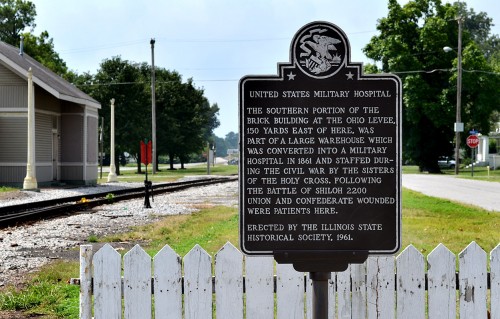 In 1861, a large brick building in Mound City was taken over by the United States Government for use as a general hospital. In service throughout the war, it was one of the largest military hospitals in the west. Another large hospital was established at Cairo.
In 1861, a large brick building in Mound City was taken over by the United States Government for use as a general hospital. In service throughout the war, it was one of the largest military hospitals in the west. Another large hospital was established at Cairo.
Roman Catholic nuns of the Order of the Holy Cross at Notre Dame, South Bend, Indiana, were utilized as nurses to staff these hospitals. The establishment of these large hospitals at Mound City and Cairo was a determining factor in the location of the Mound City National Cemetery.
The hospital at Mound City was able to accommodate from 1,000-1,500 patients and has been described as one of the best administered of the military general hospitals.
First patients came from Battle of Belmont
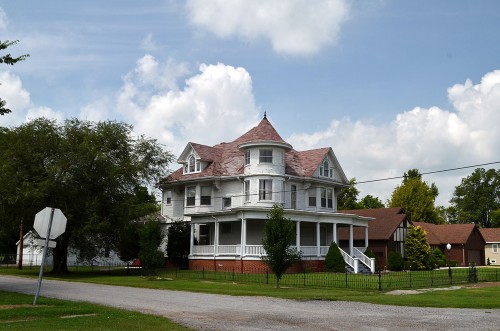 The first patients at the Mound City General Hospital were the wounded from the Battle of Belmont, Missouri, November 7, 1861. Heavy fighting at Fort Donelson, February 13-16, 1862, and at Shiloh April 6-7, 1862, brought many more patients to the Mound City and Cairo hospitals.
The first patients at the Mound City General Hospital were the wounded from the Battle of Belmont, Missouri, November 7, 1861. Heavy fighting at Fort Donelson, February 13-16, 1862, and at Shiloh April 6-7, 1862, brought many more patients to the Mound City and Cairo hospitals.
The death rate from wounds and all prevalent diseases was high in the hospitals of the Civil War period.
Other bodies were removed from Cairo and its vicinity in Pulaski County; in Missouri from Belmont in Mississippi County; Reed’s Point and Commerce in Scott County; in Kentucky from Fort Holt in Bailon County, Columbus in Hickman County, and Paducah in McCracken County.
There are 2,759 unknown soldiers buried in the Mound City National Cemetery, as well as 27 Confederate soldiers who died in the wartime hospitals of the area.
Photo gallery of Mound City
Mound City, like Cairo, has seen better days. I was fascinated by a 1905 hardware store on Main Street. I was even more fascinated when I saw the roof had fallen in and the inside was returning to nature. Click on any photo to make it larger, then use your arrow keys to move through the images.

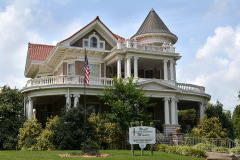
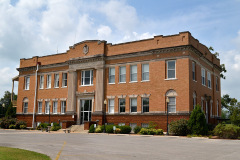
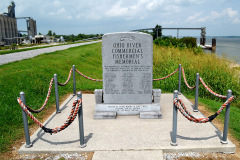
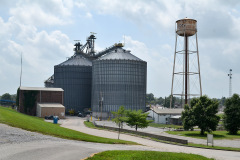
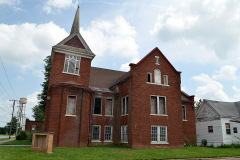
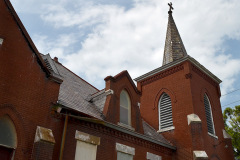
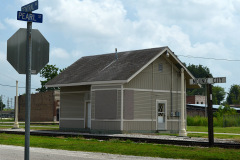
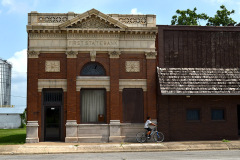
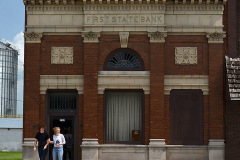
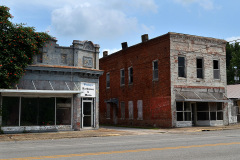
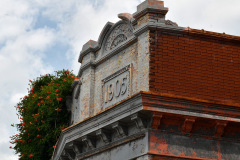
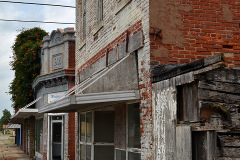


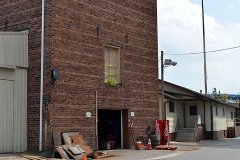
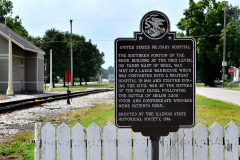
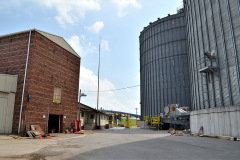
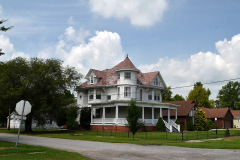
Fascinating Dr. S! Yet another place for dickie McClard aka. The ol’ rum runner. To take me on his mystery motorcycle tour this spring.
Did you mean many bodies were also brought to Mounds for burial ? in you paragraph:
Other bodies were removed from Cairo and its vicinity in Pulaski County; in Missouri from Belmont in Mississippi County; Reed’s Point and Commerce in Scott County;……….
I drove thru there just a couple of years ago. I wanted to see what was there after all these years. Seems to be a little Cairo, that is House way too big for a town this size and a little sleepy…not much going on. I did miss the cemetery, perhaps on my next visit… Great work Ken, I always enjoy taking a road less traveled.
Ken, Thanks for the update on the Mounds City Hospital. My Great Grandmother, Julia Gill served as a Cival War nurse at that hospital along with her aunt Sister Mary Magedelene, Sisters of the Holy Cross, who also served the wounded at St. Mary’s Infirmary in Cairo. The Cape Girardeau Bulletin ran a two-part article on Julia and her work as an Army nurse (she actually received a military pension). The Bulletin article shows a pen and ink sketch of the original hospital drawn by a patient and a sketch of the Red Rover, the navy’s first hospital ship, built at Cape in 1859. She was purchased by the Confederacy on November 7, 1861, and put to use as a barracks ship for the floating battery at New Orleans, Louisiana, she served at Island No. 10 until she was captured there by the Union gunboat Mound City on April 7, 1862. The shortened link to the Jan 13, 1972 Bulletin article is http://bit.ly/1yLguKD
My Shy Reader friend sent this update to the story: The Red Rover hospital boat was said to have been built in Cape Girardeau.
And the fence that runs across the front of the house at 323 Themis St., came from the Civil War hospital at Cairo, Ill. It was salvaged by our mutual friend, Judith Ann Crow.
She then sent this follow-up message: Regarding the story of the Red Rover, I’ve always had my doubts about. Cape’s not really known for having a shipyard to construct a boat. But I do know that barges were built on the riverfront. I believe Eddy Erlbacher may have done so as late as the 1930s. I wonder if the structure of the Red Rover was built here and the engines installed at Cairo…
Hi Ken,
I serve on the Mound City National Cemetery Preservation Commission Board and want to say Thank you for this article. We are trying to re-organize our museum, which is located inside the caretakers lodge at the cemetery. We are focusing on the Civil War Hospital, as that was why the cemetery was created. If you have any readers/followers out there that have artifacts they might want to loan or donate to our museum, please have them contact me.. (618) 521-5228 or by “snail” mail at MCNCPC, P O Box 45, Mound City, IL 62963. Any information or pictures would be appreciated also. We are a non-profit organization that meets on the first Monday of the month, at 6 p.m. at the caretakers lodge on the cemetery grounds. Outside of donations that we receive, our only source of funding is from the annual “Wreaths across America” event each December.
We have a Memorial Day Program (at the Cemetery) on the Saturday before Memorial Day. It will be held on Saturday, May 23, in 2015 at 10 a.m. If you happen to be in the area, I think you would enjoy this program. This year we are honoring the Vietnam Veterans.
Thanks for the info Ken… keep up the good work
Becky Mueller
Becky, Good luck.
Did you see my earlier post about the strange saga of Sgt. Ginter?
Is there any chance that the former brick United Methodist Church pictured might be for sale?
Linda, I don’t have any idea. It appears abandoned, but it may still belong to someone. I’ve only been to Mound City two or three times in the past 30 years, so I don’t have any contacts there.
Oh, another thing. There is some wierd quirk that sometimes keeps you from seeing new comments if you have already read the post. Clearing your cache will fix it. Ctrl-F5 will do it on a PC.
Linda, The Md. City Methodist Church was sold several years back for taxes, but apparently all they wanted was the stained glass windows, as they just boarded the windows and have left it sitting……. I’m not sure who bought it, but am checking on it now. If I find out, I’ll let you know.
Becky Mueller
Is the former United Methodist church pictured for sale?
Ken, can you remove my post from December 14, 2015. Both links mentioned have gone dark. The link to the Cape Bulletin article from my Dec 13 is still live. Thanks.
Your wish is my command.
It is a shame that the State of Illinois as let several of these Historical Cities, fall when they are eager to pour money into Industrial Cities and forget the one’s that made such a Historical impact in Illinois.
Hi Richard.
My name is Troy Spaulding and I grew up around that area from the late 60s through my adult life. My Grandparents and parents grew up around that area also and have so many memories. I would have loved to restored some of the old store fronts and residential properties around that area.. I have always loved where I came from.. I will never forget…
According to an article, when he died in 1932, my paternal great-grandfather Michael Williams sold newspapers at the Marine Works when he was young. Later, he became the Superintendent there. Eventually he held the same job at Paducah, KY. There are lots of memories tied to Mound City and Cairo for my generation. Anton Lutz, another great-grandfather came to Mound City to be a meat vendor for the Union Army, arriving in 1861. It’s nice to see pictures of Mound City as it was and how it stays in my memory. Many of the Mound City “Tigers” still communicate today on an e-mail list.
Hi Mary Ruth,
That would make us cousins. Michael Williams was married to my great grandfather’s sister. Hope to hear from you.?
Jeannie Fitzgerald Crawford
Email is crawford0221@yahoo.com
Me and my wife have spent a lot of time in the southern Illinois after I retired from Illinois Bell Telephone Co. We still get down that way about once a year, its sad to see a lot of the area going down the hill.
Here are two sites with really good pics of the Mounds City hospital and Red Rover. The Bing search result site has several of Ken’s photos (with credit and link to this site). You can view pics in a grid or slideshow. Each photo credits photographer and a link to the original photo website. The other site is a Southern Illinois history site.
http://binged.it/1QTPEcR http://bit.ly/1QON2QY
Sorry for the delay in getting this online. My spam filter flags any comment with two or more links in it for manual approval.
no problem, better safe than sorry. Being an admin is full-time job.
Having grown up in Mound City in the 1940 and 1950 era. Things were much different back then as compared to today. Nearly all of the building shown here were really nice places and all occupied. My mother worked at Bodes’Drug Store through the 1970s. A movie theater was located next to the old drug store. The bank was open and all of the buildings on Main St. were occupied.
A couple of years ago, my friend and I toured the town and found that nearly all of the places we remember were gone or falling down. This was a town of over 3600 people in the 1960s. It has a place in the history of the United States and in the history of Illinois. However, it is now just a memory of those of us who grew up and went to school there.
Larry Wood
My great great great grandfather was superintendent of the fiscal. War cementY at mound city and was murdered there. Does his house remain there? Are there any pictures of him? His nAme was Thomas a Fitzpatrick.
I’m sorry, I don’t have any additional information about the town. I’ve only been back there a couple times in the past 20+ years.
Would like to know the location of the launch area for the civil war iron clad USS Cairo. If any one has information I would appreciate your help
Looking for a burial site of Jeremiah Moulton Morrison who served in the 26th Maine Regiment Infantry C company from October 1862 to his death in either cairo or Mound city in August 1863.There is a memorial to him in his hometown of Mariaville Maine, but I have reason to believe that he is not buried there.
This man is buried at Mound City Nat Cemetery. Sec F #4647.
Any questions please feel free to contact me.
Thomas Mueller, President Mound City National Cemetery Preservation Commission. E mail tomins814@gmail.com
I found Sgt. Ginter’s grave in the cemetery, but I think if was in Grave 3396 in Section E. Here’s the post I did on the his strange story.
Did you check the National Cemetery between Mound City and Cairo? The largest hospital for the West/Union was located at Mound City. I believe the Sisters of Charity ran it. There is a large section of the cemetery dedicated to Civil War dead. Mound City is my hometown. Mary Ruth Lutz Harriss, Riverside CA.
Indeed, I have been to the National Cemetery. Here is a strange story about a soldier who is buried there.
Mary Ruth Harriss
My name is Jeannie Fitzgerald Crawford and my paternal grandfather was from Mound City. His Aunt married Mary Ella Fitzgerald married Michael Williams. My email is crawford0221@yahoo.com
Look forward to hearing from you
Jeannie
My dad’s paternal grandfather was William Fitzgerald who was a ship caulker. I suspect that he may have been involved in the building of these ships. Would love to find out for sure. My paternal grandfather was also a ship caulker like his dad
Does anyone have pictures or know anything about the Pulaski County Poor Farm. My mother in law was from this area. She’s 94 now and wanted a picture of it.
Thank you
Debbie
Missouri or Illinois. Google pops up quite a few references.
Looking for the poor farm in Pulaski County, Illinois. Had the same problem. Missouri keeps popping up.
“pulaski illinois county poor farm” popped up some images and references.
When you look through pictures it’s not Illinois.
Yes but when you look through pictures it’s not Illinois. They are other poor farms other states.
Sorry, I can’t help you, then. I didn’t look at the references that closely. I photographed the poor farm in Athens County back in the late 60s, and then a couple of years ago, but that’s not going to do you any good.
I’m Gerald McKinley Butler. I’m an African American Patriot, born in Mound City, IL in 1930, so I’m 90 years of age. I was a Combat Squad Leader during 13 months of the Korean War. I’d like information about Caucasian frinds of mine who also grew up in Mound City. Some were: Herman “Bud” Edwards, Lynn Lemons, “Red” Youngblood and Mark Dover. Thanks.
I hope your friends contact you. Good luck.
Gerald. Did you know a Freddie Koen?
Ken,
Do me a favor and don’t make the same mistake that everyone else does since Rear Admiral Kenney’s 1963 article listing the Red Rover being built in Cape Girardeau, Missouri in 1859.
The Steamboat Red Rover was contracted for in Louisville, Kentucky by Captain John D Taylor around 19 June 1857 after he purchased the Buckeye State for $9000 to use her engines in the new boat. Captains William Strong and Taylor had John Cunningham of Louisville construct the new boat. The Red Rover was launched in Louisville as the following newspaper article shows:
Louisville Daily Courier, Louisville, KY, Monday, October 26, 1857, p. 3, col. 4
The only problem with the article is that they stated her length at 355 ft but later corrected it to 255 ft.
According to the John Julius Guthrie papers as listed in the ORN, the Red Rover was purchased for $30,000 and Guthrie was to take command 7 November 1861 at New Orleans, LA. He was then to proceed with her to Memphis, TN on 25 November 1861, or wherever the floating battery New Orleans was . According to the same source she arrived at Columbus, KY 11 December 1861.
However the owners of the Red Rover, William Strong, John D. Taylor, W. Wyatt, Frank Shackleford, and Ammon L. Davis were not paid the $30,000 until 6 March 1862 by Commander John K. Mitchell at New Orleans, LA. That was only one month before she was captured at Island No. 10 in the Mississippi River on 8 April 1862. Strong was Owner and Master and Shackelford her Owner and Clerk when she was purchased by the Confederacy.
No one, including the US Navy, has been able to tell me where the late Rear Admiral Kenney got his Cape Girardeau information and it is not documented in his article in the Missouri Historical Review. Even Frederick Way, Jr. has her built in Louisville in 1857. I suspect he got it from Midshipman Dennis M. Davidson’s February 1960 Annapolis research paper but there is no way to tell. Davidson also does not document the Cape Girardeau build.
There was only one steamboat built here in Cape Girardeau and that was the Alfred T. Lacey and she was built in 1857 and burned in 1860.
Ray Nichols
Cape Girardeau, MO
Ray,
I’ll bow to your superior knowledge on this topic. You’ve done your research, and I commit history only by accident.
I hope this is still being monitored! Are there any remaining mounds in Mound City, of the kind for which the town is named?
I don’t know. I’m more familiar with the mounds at Wickliffe.
I’m only 36 but lived here my entire life(st.mary,camp rowdy,st.maries landing, Beauvais township,stmmarys) whatever you really prefer to call it naturally but it’s really Beauvais township by Google and st.mary locally. The picture you quoted was Clem’s shop of wonders and odd as you might think Clem’s still alive and kicking and still owns the building but I’ve seriously been looking for any kind of pictures just to see it as it was supposed to be instead of what left now. Also i can tell you directly that your 1st picture of the old house was of my great great great ain’t macks home i spent enough time there when I was a young young boy aswell my father stayed there when he was a kid you could see clean threw thew it from outside and right out the other side and if u sleep upstairs in the winter you got snowed on physically. Also a friend of a friends mom gave me a old token from before she was even born and she found it on a shelf when she moved into her old home and she came down with cancer 30 years or so later and had to sell the home but when she was moving she actually called me and asked me to stop by her home that’s when she told me about the cancer but she didn’t know anyone else with the last name of Doll besides me so she said this token is rightfully mine and the token i still have today it says “Doll’s Bar St.Mary,Mo and it’s still whole even the corners haven’t been broken off to show someone used part of it even,there’s some knowledge. People shouldn’t judge the book by the cover,i can truly only hope to one day see pictures you have b/c they burned the house down about 8 years ago neither me nor my father would go there and watch as they lit our memories up in flame,they wouldn’t do it while mack was still alive 10 years ago or so, and I’m sorry for waisting your time,good day sir.
Waste away, Sir. Your comments are what make this blog worthwhile.
These towns are dead, and have been for years. This is what happens when you wait for someone to rescue your town, v.s. rescuing yourself. There was a long stretch when just a few buildings were in trouble. Nothing was done. Then more empty buildings, then pointless demolitions rather than promoting the towns or searching for grants, etc. Other towns did, other towns have survived.
Now Cairo and Mound city are simply wide paved spots in acres of empty land
Found these articles today , very interesting. I was born in Mound City, currently live in Oregon. Was last there in 2014. I have so many good memories of my hometown and saddened by what it has become. I am always interested in reading articles and seeing pictures. Thank you for a walk down memory lane. My family moved from there when I was 12 years old in 1956. My relatives were Beaver’s, Parker’s, Burns, Lentz and Ashworth!